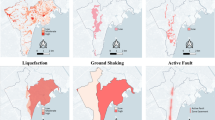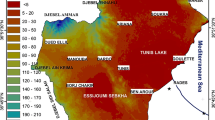Abstract
In emergency management, it is important to arrange the medical resources according to emergency needs. This paper proposes a multi-criteria decision analysis model that combines grey theory and multi-criteria decision making theory to assess the current medical resource situation, find satisfactory solutions, and help the emergency decision makers to take appropriate responses in a timely manner. In addition, the best alternative is identified by the global optimal solution which can provide a theoretical guidance for decision makers to optimize the allocation of medical resources. To validate the proposed model, this paper conducts a case study of medical service assessment in provinces of East China. The results demonstrate that the proposed model can provide objective and comprehensive assessment of medical resources.

Similar content being viewed by others
References
Ahmad, N., & Laplante, P. (2009). Using the analytical hierarchy process in selecting commercial real-time operating systems. International Journal of Information Technology and Decision Making, 8(1), 151–168.
Baker, J. R., Clayton, E. R., & Taylor, B. W. (1989). A non-linear multi-criteria programming approach for determining county emergency medical service ambulance allocations. Journal of the Operational Research, 40(5), 423–432.
Chang, T. H., & Wang, T. C. (2009). Using the fuzzy multi-criteria decision making approach for measuring the possibility of successful knowledge management. Information Sciences, 179(4), 355–370.
Chang, K. H., & Cheng, C. S. (2011). Evaluating the risk of failure using the fuzzy OWA and DEMATEL method. Journal of Intelligent Manufacturing, 22(2), 113–129.
Chen, X., Wang, Y., Wu, L. Y., Yan, G. Y., & Zhu, W. (2010). Emergency decision model with multiple stages, multiple objectives, and multidivisional cooperation. System Engineering Theory and Practice, 30(11), 1977–1985.
Chin, P. F. (2003). Manufacturing process optimization for wear property of fiber reinforced poly butylene ere phthalate composites with grey relational analysis. Wear, 254, 298–306.
Dantzig, G. B. (1963). Linear programming and extensions. Princeton: Princeton University Press.
Dean, S. F. (2008). Why the closest ambulance cannot be dispatched in an urban emergency medical services system. Prehospital and Disaster Medicine, 23(2), 161–165.
Deb, K. (2001). Multi-objective optimization using evolutionary algorithms. Chichester: Wiley.
Deng, J. L. (1982). Control problems of grey systems. Systems and Control Letters, 5(2), 288–294.
Ding, S. F., & Shi, Z. Z. (2005). Studies on incidence pattern recognition based on information entropy. Journal of Information Science, 31(6), 497–502.
Dyer, J. S., Fishburn, P. C., Steuer, R. E., Wallenius, J., & Zionts, S. (1992). Multiple criteria decision making, multiattribute utility theory: The next ten years. Management Science, 38(5), 645–654.
Evangelos, T. (1997). A sensitivity analysis approach for some deterministic multi-criteria decision making methods. Decision Sciences, 28(1), 151–194.
Gu, H., & Song, B. F. (2009). Study on effectiveness evaluation of weapon systems based on grey relational analysis and TOPSIS. Journal of Systems Engineering and Electronics, 20(1), 106–111.
Guo, Y. J., Yao, Y., & Yi, P. T. (2007). A method and application of dynamic comprehensive evaluation. Systems Engineering Theory and Practice, 27(10), 154–158.
Hammer, P. L., & Bonates, T. O. (2010). Logical analysis of data—An overview: From combinatorial optimization to medical applications. Annals of Operations Research, 148(1), 203–225.
Hamzaçebi, C., & Pekkaya, M. (2011). Determining of stock investments with grey relational analysis. Expert Systems with Applications, 33(8), 9186–9195.
Han, Z. Y., Weng, W. G., Zhang, W., & Yang, L. X. (2009). Backgrounds, targets and organization of the major research plan “study on unconventional emergencies management”. Science Foundation of China, 23(4), 215–220.
Hoetmer, G. J. (1991). Emergency management: Principles and practice for local government. Washington DC: International City Management Association.
Hsu, L. C., & Wang, C. H. (2009). Forecasting integrated circuit output using multivariate grey model and grey relational analysis. Expert Systems with Applications, 36(1), 1403–1409.
Hutton, B., & Charles, P. S. (1988). Sensitivity analysis of additive multi-attribute value models. Operations Research, 36(1), 122–127.
Isaacs, H. H. (1963). Sensitivity of decision to probability estimation errors. Operations Research, 11, 536–552.
Jlassi, J., Mhamedi, E. A., & Chabchoub, H. (2011). Technical note: The improvement of the performance of the emergency department: Application of simulation model and multiple criteria decision method. Journal of Industrial Engineering International, 7(12), 60–71.
Kao, P. S., & Hocheng, H. (2003). Optimization of electrochemical polishing of stainless steel by grey relational analysis. Journal of Materials Processing Technology, 140, 255–259.
Kou, G., Lu, Y., Peng, Y., & Shi, Y. (2012). Evaluation of classification algorithms using MCDM and rank correlation. International Journal of Information Technology & Decision Making, 11(1), 197–225. doi:10.1142/S0219622012500095.
Linkov, I., Satterstrom, F. K., Kiker, G., Batchelor, C., Bridges, T., & Ferguson, E. (2006). From comparative risk assessment to multi-criteria decision analysis and adaptive management: Recent developments and applications. Environment International, 32(8), 1072–1093.
Liou, J., Hsu, C. C., Yeh, W. C., & Lin, R. H. (2011). Using a modified grey relation method for improving airline service quality. Tourism Management, 32(6), 1381–1388.
Maguire, B. J., Hunting, K. L., Smith, G. S., & Levick, N. R. (2002). Occupational fatalities in emergency medical services: A hidden crisis. Annals of Emergency Medicine, 40, 625–632.
Nakhaeizadeh, G., & Schnabl, A. (1997). Development of multi-criteria metrics for evaluation of data mining algorithms. In Proceedings of Third International Conference on Knowledge Discovery and Data Mining (pp. 37–42). Newport Beach, California, USA.
National Incident Management System (NIMS). (2011). United States, Federal Emergency Management Agency, http://www.fema.gov/emergency/nims/. Accessed 15 Aug 2011.
Nolte, E., & McKee, M. C. (2008). Measuring the health of nations: Updating an earlier analysis. Health Affairs, 27(1), 58–71.
Noyan, N. (2010). Alternate risk measures for emergency medical service system design. Annals of Operations Research, 181(1), 559–589.
Open Advanced System for dISaster end emergency management (OASIS). (2008). Decision support activities research report, OASIS FP6 Consortium, http://www.oasis-fp6.org/. Accessed 15 Aug 2011.
Papamichail, K. N., & French, S. (2005). Design and evaluation of an intelligent decision support system for nuclear emergencies. Decision Support Systems, 41(1), 84–111.
Peng, Y., Zhang, Y., & Tang, Y. (2011a). An incident information management framework based on data integration, data mining, and multi-criteria decision making. Decision Support Systems, 51, 316–327.
Peng, Y., Kou, G., Wang, G., & Shi, Y. (2011). FAMCDM: A fusion approach of MCDM methods to rank multiclass classification algorithms. Omega, 39(6), 677–689. doi:10.1016/j.omega.2011.01.009.
Peng, Y., Kou, G., Wang, G., Wu, W., & Shi, Y. (2011c). Ensemble of software defect predictors: An AHP-based evaluation method. International Journal of Information Technology & Decision Making, 10(1), 187–206. doi:10.1142/S0219622011004282.
Pfeuffer, F., Stiglmayr, M., & Klamroth, K. (2012). Discrete and geometric branch and bound algorithms for medical image registration. Annals of Operations Research, 196(1), 737–765.
Rokach, L. (2010). Ensemble-based classifiers. Artificial Intelligence Review, 33(1–2), 1–39.
Shi, K. (1990). Grey relation theory and its applications. In Proceedings of the first International Symposium on Uncertainty Modeling and Analysis, College Park, Maryland, USA (pp. 404–408).
Sokol, M. C., McGuigan, K. A., Verbrugge, R. R., & Epstein, R. S. (2005). Impact of medication adherence on hospitalization risk and healthcare cost. Medical Care, 43(6), 521–530.
Tufekci, S., & Wallace, W. A. (1998). The emerging area of emergency management and engineering. IEEE Transactions on Engineering Management, 45(2), 103–105.
Yager, R. R. (1988). On ordered weight averaging aggregation operators in multi-criteria decision making. IEEE Trans on Systems, Man and Cybernetics, 18(1), 183–190.
Yang, Y. Y., & Liu, Y. T. (2008). Equalization research on public health and basic medical services of provinces. Research on Economic and Management, 5, 11–17.
Yoon, S. W., Velasquez, J. D., Partridge, B. K., & Nof, S. Y. (2008). Transportation security decision support system for emergency response: A training prototype. Decision Support Systems, 46(1), 139–148.
Zou, Z. H., Sun, J. N., & Ren, G. P. (2005). Study and application on the entropy method for determination of weight of evaluating indicators in fuzzy synthetic evaluation for water quality assessment. ACTA Scientiae Circumstantiate, 25(4), 552–556.
Acknowledgments
The authors are grateful to the reviewers for their valuable suggestions which helped in improving the quality of this paper. This research has been partially supported by Grants from the National Natural Science Foundation of China (#71222108), the Research Fund for the Doctoral Program of Higher Education (#20120185110031) and Program for New Century Excellent Talents in University (NCET-10-0293).
Author information
Authors and Affiliations
Corresponding author
Rights and permissions
About this article
Cite this article
Kou, G., Wu, W. Multi-criteria decision analysis for emergency medical service assessment. Ann Oper Res 223, 239–254 (2014). https://doi.org/10.1007/s10479-014-1630-6
Published:
Issue Date:
DOI: https://doi.org/10.1007/s10479-014-1630-6




